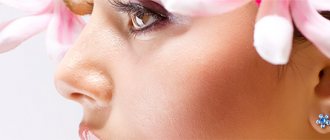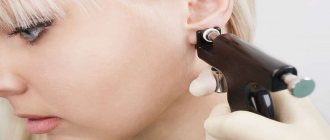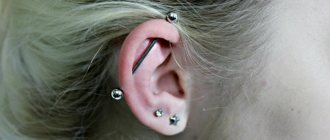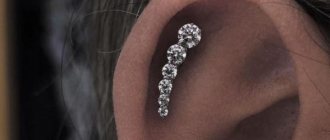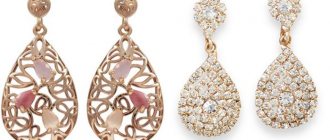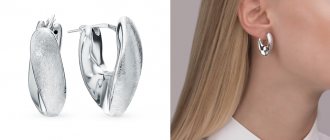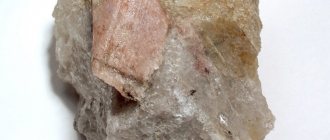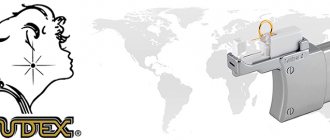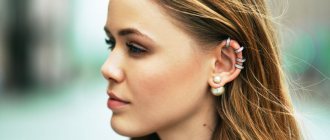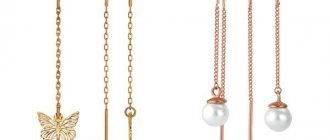Helix piercing
The name of the piercing comes from the English word Helix. A helix piercing means a piercing on the top of the ear or the helix of the ear. The hole created by puncturing the cartilage tissue is used to wear various types of jewelry.
Helix ear piercing
Helix piercing is popular among both women and men. Those who like to pierce the body can be found among people of different generations. You can choose any type of decoration to express yourself.
Types of products
Immediately after piercing, a labret with a twist is inserted.
Types of cheats:
- rounded shape with opals or cubic zirconia;
- shaped titanium wraps;
- with different stones.
Clusters are often chosen for piercing. A cluster is a decoration where several parts are connected.
Hoop earrings can only be installed after 3 months.
Can be used:
- Circulars;
- Carnations;
- Bananas.
How is this piercing done?
The basis for successful piercing is the right choice of the master. You should read reviews about the salon and the level of professionalism of the craftsmen in advance. The best option would be to have the puncture procedure performed by a master with a medical education.
Beauty salons that value their reputation provide piercing services in accordance with all hygiene standards. The office must have a disinfection system, medical personnel are equipped with special clothing and sterile self-defense equipment (masks and gloves) for carrying out simple surgical procedures.
The seemingly simple procedure of cartilage puncture has a number of consequences that must be foreseen in advance. There are 2 ways to pierce the ear helix. 1st method - puncture with a pistol. 2nd method - needle with catheter.
In modern salons, the practice of piercing the ear with a gun has long faded into the background, since this procedure has serious side effects and can cause infection with serious diseases. Pistol piercing destroys cartilage, which leads to inflammation and prolonged healing.
The safest is to pierce the ear with a special needle and catheter. A sharp needle allows you to make a hole of the required diameter and painlessly insert the labret into the puncture.
Why complications arise
The reasons for an unsuccessful puncture, depending on who provoked the complications, can be divided into two groups:
- Complications due to the fault of the master. Masters who work at home without the appropriate certificates and permits often make the procedure unsafe: they do not maintain sterility, do not undergo medical examinations, and pierce incorrectly. As a result, an infection enters the wound, and the instrument damages nerves and blood vessels.
- Complications caused by the client. Often clients are not ready for a long recovery period and do not follow the specialist’s recommendations. The wound requires careful, long-term care over several months, and if the wound is not treated or injured, this leads to infection.
Procedure and complexity of the puncture
Before the piercing procedure, you need to familiarize yourself with the important rules for its implementation, and also make sure that there are no contraindications.
Helix (ear piercing in the upper area of the arch) is contraindicated in the following cases:
- skin diseases (acute and chronic);
- cuts, scratches, damage to the skin;
- acute respiratory diseases and inflammatory processes of the middle ear;
- allergic reaction to metals;
- cardiovascular diseases;
- hypertonic disease;
- peptic ulcer of the gastrointestinal tract;
- benign formations;
- diabetes;
- mental disorders;
- diseases associated with blood clotting disorders;
- renal failure;
- pregnancy and lactation period.
Before starting the procedure, you must select the jewelry that will be installed for initial wear. Before the procedure, the master must place the jewelry in a container with a disinfection solution.
Piercing jewelry provided in the salon is sterile and stored in individual packaging. Often such jewelry is made of surgical steel, titanium or bioplastic. These materials are hypoallergenic, have a smooth surface and optimal dimensions to promote rapid wound healing.
The sequence of piercing the ear using a catheter:
- The puncture site is treated with a disinfectant solution.
- A mark is placed on the auricle with a special marker.
- The ear is fixed with a special clamp with a window opening.
- The master pierces the ear with a catheter, maintaining a certain angle to form the correct location of the channel.
- The needle is removed and only the catheter is left in the hole.
- In order to insert the jewelry, the labret rod is inserted into the catheter tube and, using light pressure, it is gradually advanced, pushing out the catheter.
- The specialist gives recommendations on caring for the wound surface of the puncture.
Another, faster method, but which brings more discomfort during healing, is puncture with a gun.
Helix (ear piercing accompanied by damage to cartilage) is pierced with a disposable stud earring. The surface of the ear is treated with a disinfectant solution, and the earring removed from the sterile packaging is inserted into the gun. A mark is placed on the pinna and a quick puncture is made.
Disadvantages of piercing cartilage with a gun:
- The earring used for the puncture has a small diameter, so it will be impossible to install jewelry with a larger diameter, since the cartilage tissue does not stretch.
- Piercing jewelry is short in length, so if there is swelling, the earring may put pressure on the tissue, which can significantly complicate the healing process.
- When punctured with a gun, the cartilage tissue can be crushed, which will lead to tissue swelling and a long recovery period.
Further care (after a month)
Primary healing has passed, but this is not the end of care. We do not recommend changing the decoration yourself ; this is often not done very carefully. Minor but frequent trauma can lead to severe damage and the healing process from the beginning. You should not wear jewelry of poor quality, as the materials from which they are made can cause an allergic reaction. Treat your piercing several times a week (you already know how to treat a Helix piercing). If you notice that after sleeping there is discomfort in the puncture or the puncture swells, you should avoid sleeping on this side .
Jewelry options
The choice of jewelry depends on your own taste, style and ease of wearing. Piercing jewelry is a way of self-expression.
For some, it is an art and philosophy that allows them to express their freedom and stand out from the crowd.
How to choose jewelry
During the healing period of the helix, it is better to choose jewelry with a straight rod called a labret. This jewelry is a barbell with a diameter from 1 mm to 1.6 mm and a length from 4 mm to 18 mm. On one side, the decoration has a flat welded disk, on the other there is a thread, which can be internal or external. A nozzle in the form of various shapes, crystals, spikes, and balls is screwed onto the thread.
Straight jewelry with a large shaft diameter is convenient for healing, since it does not change the direction of the puncture channel and protects the ear from tissue ruptures due to accidental tugging. It is not recommended to install ring piercings into Helix piercings. The thin diameter and constant rotation disrupt the wound surface and increase the healing time. Twisting the ring and damaging the healing area can lead to tissue infection.
For constant wear, you can choose products to your taste from the material you like.
The following products are most often chosen to be worn in a helix:
- labret;
- barbell;
- ring.
Product materials
In order to avoid side effects from piercing, you need to take the choice of jewelry and its composition seriously.
The most popular materials for jewelry used as primary materials for wound healing are shown in the table below.
| Decoration material | Characteristic |
| Gold | The popular 585 gold standard, available in jewelry stores, contains nickel, which is the main component that causes skin dermatitis and allergies. Gold jewelry is not recommended for initial wear. |
| Silver | The ability to oxidize is not allowed to wear silver jewelry as a healing item. |
| Titanium | The lightness and hypoallergenicity of implant titanium makes it popular for the period of tissue restoration after a puncture |
| Surgical steel | The cheapness and relative inertness of steel jewelry makes them the most popular among items for primary wear. But nickel, which is part of the alloy, can cause allergies or dermatitis. |
| Bioplast, bioflex | Light, weightless, hypoallergenic products are the best option for restoring puncture tissue. The smooth rod and internal thread do not contribute to the growth of bacteria on its surface. Inert to many chemicals, allows you to treat the wound with various disinfectants |
For permanent use, you can choose products from any material you like. The main condition is that the earring does not cause permanent injury to the puncture and is safe for the skin.
Types of products
Helix (ear piercing can be double or triple), due to its location, involves wearing several types of products. This cartilage puncture site is most convenient for wearing straight jewelry or rings.
Types of rings for piercing:
- A ring connected by a ball, which can be metal, decorated with crystal or plastic inserts of various types.
- Detachable segment product. It is divided into parts and can have a different textured surface, decorated with images, crystals, inscriptions, and spikes.
- Earring in the form of a figured ring with inscriptions or with a pendant. It can have different diameters and a wide selection of pendants with types of symbols, figures, and crystals.
Another popular helix decoration is the labret.
According to the type of structure, labrets are divided into two types:
- Products with external thread. When the thread is on the outside of the rod and decorations are screwed onto it.
- Jewelry with internal carvings. The rod has a recess into which the decoration is screwed, equipped with a welded threaded attachment.
Types of decorations for labret:
- Wrap in the form of a ball, spike or other geometric shape.
- A metal symbol, inlaid with or without crystals.
- Rolled stone.
- Crystal in a frame.
- A faceted stone with a flat base.
- A cluster in the form of several elements digested with each other with and without stones
- A wrap equipped with a removable pendant.
In order to change the style of decoration, it is not necessary to buy the whole product, just choose a new wrap with a thread of the appropriate diameter.
You can also use a barbell as a decoration by screwing various attachments onto it.
Particularly bright and varied are products made from bioplast or bioflex, which have a variety of shades and caps of various shapes.
Expert opinion
Dmitry Karpova, tattoo and piercing artist at Dragon Tattoo salon:
– Piercing has few contraindications – problems with blood clotting and skin diseases (eczema, psoriasis) in moments of exacerbation. Also, you should not pierce anything when the body is recovering from surgery or illness. In the first few weeks after visiting the piercing salon, it is not recommended to visit the bathhouse or lie in a bath of hot water for a long time. If you steam the puncture site, the healing process will be delayed. For the same reason, you should postpone going to the pool. And, of course, if you don’t want to get an infection into the wound, forget about swimming in fresh water. But sea water, on the contrary, is useful, but only if it is clean.
How does a Helix ear piercing usually heal, consequences?
Helix (ear piercing, accompanied by a hole passing through the cartilage), as a procedure involving tissue damage, can have complications and undesirable consequences.
First of all, you need to exclude all contraindications. Tissue puncture is stressful, which can affect the stability of internal processes in various diseases. Thus, it is possible for benign neoplasms to degenerate into malignant ones, or to provoke the risk of cardiac complications in case of existing diseases of the cardiovascular system. Piercing during pregnancy can provoke contractions and premature birth, which is especially dangerous in the early stages.
The healing period of a cartilage puncture ranges from 2 months to 1 year. Maximum swelling of the puncture site appears after 2-3 days. The size of the swelling can be 3 times the normal thickness of the auricle. That is why it is recommended to install products with a long rod. Swelling can last up to 2 weeks.
During the healing process, it is necessary to follow the rules of care to avoid unwanted consequences.
Complications possible with helix puncture:
- Primary infection caused by a procedure under unsterile conditions using unsterile equipment and materials, causing sepsis, edema, and inflammation.
- Infection with hepatitis and HIV viruses. This is possible by piercing the ear with a gun, which is difficult to completely disinfect.
- The occurrence of inflammation, purulent tubercles, infiltrates if the rules of care for the wound surface are not followed.
- Provoking the growth of keloid, hypertrophic scars at the puncture site. This may depend on the inexperience of the master or on the characteristics of the body.
- Rupture of ear tissue due to the wrong choice of jewelry for initial wear.
The center of the world
When you decide to decorate your navel with a flirty earring, keep in mind that piercings in this area take a very long time to heal. Therefore, you need to take care of it for at least a month, even if you are not bothered by unpleasant sensations, the swelling and redness will subside. Otherwise, you risk complications in the form of inflammation and subsequent removal of the earring. And in general, the navel is a capricious place. If you fall into the hands of an incompetent master, all hell breaks loose. The fact is that for piercing in this area, the distance between the “input” and “output” holes is extremely important: on average it should be 1.2 cm. If you make a larger gap, the earring will “sink” in the stomach and a specialist will have to get it out from there . A shorter period between punctures may result in the skin not being able to withstand the load, breaking, and the jewelry falling off.
An earring can also pierce the skin on your eyebrows: therefore, if you are going to get a piercing in this area, choose the lightest possible jewelry. Also, be prepared for the fact that if you injure the puncture while washing your face or when you begin to pull your T-shirt over your head, a bruise will appear on your eyebrow, similar to a bruise.
How to care for an ear piercing
Helix and wearing jewelry in the piercing of the upper curl of the ear looks stylish and attractive. To make your piercing look neat and beautiful, you must patiently and competently follow all the recommendations for proper healing of the wound surface.
First of all, you need to remember the following rules:
- Do not twist or remove the installed decoration. If the labret accidentally unscrews and falls out, you must contact a specialist for help with installation.
- Use products recommended by a specialist in the piercing salon for disinfection and disinfection.
- Do not use alcohol, hydrogen peroxide or ointments for treatment, which can cause burns or provoke the proliferation of pathogenic microflora.
- Avoid contact with hair, shampoo and other decorative or skincare products at the piercing site.
- At first, avoid the consumption of alcohol, nicotine, coffee, which can affect blood circulation and reduce the quality of tissue repair.
- In the first month after the procedure, avoid visiting open water bodies, baths and swimming pools.
- Carefully monitor the cleanliness of bed linen to prevent infection.
- Do not use over-the-ear headphones to listen to music.
- Use hair care products carefully to avoid accidentally touching the piercing.
To help the body heal a wound as quickly as possible, you need to eat right and maintain a healthy lifestyle. At the same time, in the first 10 days, it is necessary to especially carefully monitor and treat the wound surface.
Piercing care rules:
- Twice a day it is necessary to wash the puncture site with saline solution. To do this, you can make baths and place the puncture in the solution for 2-3 minutes.
- After washing the wound, the piercing site should be disinfected with an antiseptic. Miramistin or Chlorhexidine are most often used.
- For the first 10 days you should not sleep on your side where your ear was pierced.
- The piercing site should be covered with a bactericidal plaster, especially during sleep, when treating hair with sprays, and when going outside.
- After 10 days, you can begin to wash the ear with soap and water and carefully monitor the cleanliness of the skin.
- You should only touch the piercing with clean hands.
- If itching, swelling, redness or suppuration occurs, you should contact a piercer or a dermatologist.
- After about 2 months, with successful healing, you need to contact the salon to replace the jewelry with a shorter one.
The most popular place for piercing is the ear. Helix is a puncture of the cartilage of the upper part of the arch of the auricle. A wide variety of costume jewelry and jewelry has been created for decoration. Patient care and adherence to the rules will allow you to restore the puncture site in the shortest possible time and avoid complications.
If your ear hurts or festeres after a piercing
After ear piercing there can be different consequences. Immediately after the piercing, swelling will begin. There is no need to remove it - with normal healing it will go away the next day. If this does not happen, and the ear is completely swollen, then suppuration of the lobes or cartilage begins.
Ear piercing inflammation
Tips on what to do if your ear festers:
- The piercing site must be thoroughly treated with an antiseptic. Miramistin is ideal;
- To prevent lumps from forming at the ear piercing site in the future, you need to lightly knead the tissue every day. If numerous granulomas have already appeared, only professional treatment will help;
- It is strictly forbidden to sleep on the side of the punctures. This contributes to poor circulation;
- If a lump has formed there that hurts or itches, it’s a granuloma. It is a “skin bag” containing pus inside. The most important thing is to remove the purulent fluid. Ichthyol ointment, onion gruel, aloe leaves will help with this;
Ear inflammation after piercing - Any of the selected products is applied as a compress to the affected area for several hours. After 2–3 hours, remove the compress and replace it with a new one. After the second time, you need to rinse the hole with hydrogen peroxide; in most cases, this is enough for the pus to begin to come out;
- If the ball is too large, then it is optimal to squeeze out the pus manually. To do this, take a cotton pad and moisten it generously with any available antiseptic. Just below the puncture site, begin to apply light pressure on the lump. Pus will come out of the hole. As soon as this happens, press a little harder. To finally get rid of the granuloma, apply a compress with ichthyol ointment to the piercing site.
In addition, even despite proper care and careful handling of the puncture, the body may begin to reject the earring. During the process, the temperature may rise, the ear will become very sore, and pus may even be discharged. You can try installing an earring made of noble metal or a ring (this will make it easier to wash). If this does not help, you will have to remove the jewelry.
